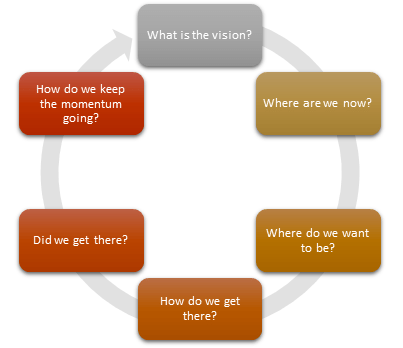
Improvements are quite sensible things. First of all, effort (sometimes significant) needs to be invested in order to detect and start an improvement initiative. Secondly, once you have the improvement defined, it’s important that there is a process in place that will implement that initiative – a managed process. In such way, everyone involved in the company’s IT Service Management (ITSM) will know: “Great, when I start an improvement initiative there is someone to take care of it and do something.”
ITIL emphasizes improvement throughout all processes and the service lifecycle. Let’s see what the characteristics are of the improvement implementation. Read the article ITIL Continual Service Improvement – don’t lose the momentum to get more knowledge about CSI.
Starting an improvement initiative just to finish it as another task is wrong. Maybe it doesn’t necessarily look that way, but an improvement initiative affects all of a company’s levels – from strategic down to the individual level. Based on that fact, it’s logical that a managed approach is needed to implement improvement initiative(s). The CSI approach does exactly that – it provides a managed way to handle improvement initiatives for all interested parties and the company itself, as well as teams or individuals.
Let’s see what the steps in the CSI approach are.

Figure: CSI approach
What is the vision? – Some smaller companies don’t invest many resources in developing and maintaining their mission and vision statements. But, I’m sure that the management or the owner of the company has them. The vision is your guiding line, a goal you want your organization to achieve in the long run. Although creating a vision statement can sound like a fancy bureaucratic activity, it’s important to have one.
You need to know where your organization is going; i.e., it must be clear to everyone in your company how they contribute to the company’s success. In practice, this means that before the real work on an improvement initiative starts, it must be clear why you are doing this, who is involved, and how to get everyone involved “on board.”
Where are we now? – This is an important step in implementing the improvement initiative. In this stage, you will assess your baseline or your starting point. This is important because you have to decide about the right approach and, once you are done with the implementation, compare the end state with the beginning state. Additionally, during this phase of the improvement implementation, you need to assess current capabilities (e.g., capabilities of your employees) in order to develop them further in the desired direction (for example, know-how that you need to implement the improvement) or to gain an understanding of how to best utilize existing capabilities.
Where do we want to be? – There are several elements that need to be clarified before the real work begins:
How do we get there? – This is the moment when you will define how the improvement will be implemented. Once you have a plan (how and what you need to do; read the article Service Improvement Plan – For the sake of improvements to learn more ) – you can begin with the implementation. Make sure that you defined (i.e., planned) measurable targets (new functionality) to test and measure until you are sure that you are done with the implementation.
Did we get there? – Once you implement the improvement(s), it must be made sure that the desired future state has been reached. During planning for the implementation, you defined CSFs (Critical Success Factors) and associated KPIs (Key Performance Indicators). It’s time to check whether your decision at the beginning (what is the target of the improvement initiative, and how do you reach it) was the right one. Read the article ITIL CSI 7-step improvement process: What is it all about? to learn more.
How do we keep the momentum going? – It’s in your best interest (and your company’s, too) that improvement is not just a one-time job. Quite the contrary – use the lessons learned in order to make implementation of improvement initiatives even more productive.
So, you may ask yourself – What do you do with the CSI approach? The idea behind the CSI approach is to make it an everyday practice. Depending on your company and the services you support (i.e., from a complexity or a technological point of view), some of the improvement initiatives will go deeper into processes, organization, services… while some of them will stay on the “surface.” But, the important thing is that you integrate improvement as a standard activity in all your processes and throughout the ITSM organization.
The expected benefits do not only include the services you support. They also include your organization, people, and processes. And, do you know what? One of the included processes is – CSI. Efficiency of implemented improvements on CSI affects the whole organization and all other processes. So, be particularly careful with this one.
Use this free ITIL Gap analysis tool to assess whether your current CSI activities are compliant with ITIL recommendations.